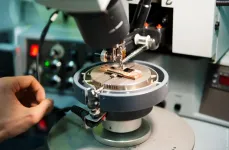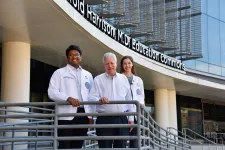(Press-News.org) Though our galaxy is an immense city of at least 200 billion stars, the details of how they formed remain largely cloaked in mystery.
Scientists know that stars form from the collapse of huge hydrogen clouds that are squeezed under gravity to the point where nuclear fusion ignites. But only about 30 percent of the cloud's initial mass winds up as a newborn star. Where does the rest of the hydrogen go during such a terribly inefficient process?
It has been assumed that a newly forming star blows off a lot of hot gas through lightsaber-shaped outflowing jets and hurricane-like winds launched from the encircling disk by powerful magnetic fields. These fireworks should squelch further growth of the central star. But a new, comprehensive Hubble survey shows that this most common explanation doesn't seem to work, leaving astronomers puzzled.
Researchers used data previously collected from NASA's Hubble and Spitzer space telescopes and the European Space Agency's Herschel Space Telescope to analyze 304 developing stars, called protostars, in the Orion Complex, the nearest major star-forming region to Earth. (Spitzer and Herschel are no longer operational).
In this largest-ever survey of nascent stars to date, researchers are finding that gas-clearing by a star's outflow may not be as important in determining its final mass as conventional theories suggest. The researchers' goal was to determine whether stellar outflows halt the infall of gas onto a star and stop it from growing.
Instead, they found that the cavities in the surrounding gas cloud sculpted by a forming star's outflow did not grow regularly as they matured, as theories propose.
"In one stellar formation model, if you start out with a small cavity, as the protostar rapidly becomes more evolved, its outflow creates an ever-larger cavity until the surrounding gas is eventually blown away, leaving an isolated star," explained lead researcher Nolan Habel of the University of Toledo in Ohio.
"Our observations indicate there is no progressive growth that we can find, so the cavities are not growing until they push out all of the mass in the cloud. So, there must be some other process going on that gets rid of the gas that doesn't end up in the star."
The team's results will appear in an upcoming issue of The Astrophysical Journal.
A Star is Born
During a star's relatively brief birthing stage, lasting only about 500,000 years, the star quickly bulks up on mass. What gets messy is that, as the star grows, it launches a wind, as well as a pair of spinning, lawn-sprinkler-style jets shooting off in opposite directions. These outflows begin to eat away at the surrounding cloud, creating cavities in the gas.
Popular theories predict that as the young star evolves and the outflows continue, the cavities grow wider until the entire gas cloud around the star is completely pushed away. With its gas tank empty, the star stops accreting mass - in other words, it stops growing.
To look for cavity growth, the researchers first sorted the protostars by age by analyzing Herschel and Spitzer data of each star's light output. The protostars in the Hubble observations were also observed as part of the Herschel telescope's Herschel Orion Protostar Survey.
Then the astronomers observed the cavities in near-infrared light with Hubble's Near-infrared Camera and Multi-object Spectrometer and Wide Field Camera 3. The observations were taken between 2008 and 2017. Although the stars themselves are shrouded in dust, they emit powerful radiation which strikes the cavity walls and scatters off dust grains, illuminating the gaps in the gaseous envelopes in infrared light.
The Hubble images reveal the details of the cavities produced by protostars at various stages of evolution. Habel's team used the images to measure the structures' shapes and estimate the volumes of gas cleared out to form the cavities. From this analysis, they could estimate the amount of mass that had been cleared out by the stars' outbursts.
"We find that at the end of the protostellar phase, where most of the gas has fallen from the surrounding cloud onto the star, a number of young stars still have fairly narrow cavities," said team member Tom Megeath of the University of Toledo. "So, this picture that is still commonly held of what determines the mass of a star and what halts the infall of gas is that this growing outflow cavity scoops up all of the gas. This has been pretty fundamental to our idea of how star formation proceeds, but it just doesn't seem to fit the data here."
Future telescopes such as NASA's upcoming James Webb Space Telescope will probe deeper into a protostar's formation process. Webb spectroscopic observations will observe the inner regions of disks surrounding protostars in infrared light, looking for jets in the youngest sources. Webb also will help astronomers measure the accretion rate of material from the disk onto the star, and study how the inner disk is interacting with the outflow.
INFORMATION:
Credits: NASA, ESA, and N. Habel and S. T. Megeath (University of Toledo)
Media Contacts:
Claire Andreoli
NASA's Goddard Space Flight Center, Greenbelt, Maryland
301-286-1940
claire.andreoli@nasa.gov
Donna Weaver / Ray Villard
Space Telescope Science Institute, Baltimore, Maryland
410-338-4493 / 410-338-4514
dweaver@stsci.edu / villard@stsci.edu
Christine Billau
University of Toledo, Toledo, Ohio
419-530-2077
christine.billau@utoledo.edu
Science Contacts:
Nolan Habel / Tom Megeath
University of Toledo, Toledo, Ohio
nolan.habel@rockets.utoledo.edu / s.megeath@utoledo.edu
NEW YORK, NY (March 18, 2021)--Therapies that soothe inflammation could be an effective way to prevent heart disease in people with a common age-related blood condition, according to a new study from researchers at Columbia University Vagelos College of Physicians and Surgeons.
The researchers identified how the blood condition, called clonal hematopoiesis, worsens atherosclerosis, and their findings suggest that an anti-inflammatory drug previously tested in a wider population of people with cardiovascular disease may have potential if used only in those with clonal hematopoiesis.
"The main message from our research is that anti-inflammatory therapies for atherosclerotic heart disease may be particularly effective in patients with clonal hematopoiesis," says Alan Tall, ...
A Russian-German research team has created a quantum sensor that grants access to measurement and manipulation of individual two-level defects in qubits. The study by NUST MISIS, Russian Quantum Center and the Karlsruhe Institute of Technology, published in npj Quantum Information, may pave the way for quantum computing.
In quantum computing the information is encoded in qubits. Qubits (or quantum bits), the quantum mechanical analogue of a classical bit, are coherent two-level systems. A leading qubit modality today superconducting qubits based on the Josephson junction. That is the kind of qubit IBM and Google used in their quantum processors. However, scientists are still searching for the perfect qubit -- the one that can be precisely measured and controlled, ...
Researchers are developing new autonomous technologies that can help people check that isolated elderly family members are okay.
We are living in a world where elderly parents are increasingly distant from their relatives, as many relocate for work opportunities.
There are now more than 4 million people aged 65 and older who are living alone in the UK.
The series of national lockdowns during the coronavirus pandemic has made it even harder for people to check that those elderly loved ones are safe and well.
Families want peace of mind that their elderly relatives are living well, and are maintaining a relatively active lifestyle. Although we can call them to check ...
UNIVERSITY PARK, Pa. -- A team led by researchers in Penn State's College of Agricultural Sciences has developed a diagnostic test that can identify virulent forms of the swine bacterial pathogen Streptococcus equi subspecies zooepidemicus -- often referred to as "Strep zoo" -- which can cause severe illness and death in pigs, other animals and rarely people.
Outbreaks of S. zooepidemicus causing high mortality in swine first were reported in Asia in 1977, and until recently, the pathogen was not thought to be a major concern in North America. However, high-mortality Strep zoo outbreaks occurred in swine herds in Canada, Tennessee, Ohio and Pennsylvania in 2019. Different versions of the pathogen also can cause a range of disease symptoms ...
BOSTON - Patients who regurgitate regularly but without any known cause may have a condition called rumination. Unfortunately, rumination is often confused with other gastrointestinal conditions, which means many patients may not be getting prompt treatment. But a new study by investigators at Massachusetts General Hospital (MGH) in Neurogastroenterology and Motility clearly describes this syndrome, how to distinguish it from other conditions, and how to treat it.
Rumination syndrome is a behavioral problem, in which patients effortlessly and repeatedly regurgitate food into their mouths while eating and sitting upright. It is a learned behavior that is classified as a disorder ...
Announcing a new article publication for BIO Integration journal. In this review article the authors Yingxue Deng, Rui Huang, Songyin Huang and Menghua Xiong from South China University of Technology, Guangzhou, Guangdong, P. R. China and Sun Yat-sen University, Guangzhou, Guangdong, P. R. China discuss how nanoparticles enable efficient delivery of antimicrobial peptides for the treatment of deep infections.
Antimicrobial peptides (AMPs) are rarely directly used to treat deep infections due to their systemic toxicity and low bioavailability. The authors summarize recent progress that researchers employed nanoparticles based delivery systems to deliver AMPs for the treatment of deep infections.
Nanoparticles-based delivery systems offer a strategy ...
(Boston)-- Uncontrolled diabetes increases maternal and fetal risks during pregnancy. As a result, the American Diabetes Association (ADA) recommends that family planning should be discussed and effective contraception should be available to the more than three percent of (more than one million) reproductive-age women in the United States with diabetes. Yet a new study has found that women with diabetes are less likely to use contraception after their diabetes diagnosis.
"Efforts are needed to ensure that women with diabetes receive the counseling and clinical services needed to carefully plan their pregnancies," said corresponding author Mara Murray Horwitz, MD, assistant ...
When the COVID-19 pandemic forced medical students out of classrooms and clinical rotations this time last year, the state of Georgia's only public medical school had to quickly rethink its traditional curriculum.
Faculty and staff at the Medical College of Georgia at Augusta University were able to quickly adapt and provide an online platform for learning about the pandemic and initiating student-led service projects to aid frontline workers and help educate the public, MCG faculty and students write in a review article in the journal Medical Science Educator.
The University System of Georgia suspended in-classroom learning ...
Prior infection with COVID-19 protects most people against reinfection, with 0.65% of patients returning a positive PCR test twice during Denmark's first and second waves, compared with 3.27% of people who tested positive after initially being negative.
People over the age of 65 are at greater risk of catching COVID-19 again, with only 47% protection against repeat infection compared with 80% for younger people.
Protection against reinfection remained stable for more than six months.
The findings underline that measures to protect the elderly - including social distancing and vaccinations are essential even if people have already been diagnosed with COVID-19.
The analysis focused on the original COVID-19 strain and made no assessment ...
When it comes to adapting to new situations, goats are a step ahead. Compared to sheep, they can more quickly adapt to changing environmental conditions. These are the findings of a new study by researchers at Martin Luther University Halle-Wittenberg (MLU) and the Leibniz Institute for Farm Animal Biology (FBN) which were published in Royal Society Open Science. The study investigated how well the animals were able to navigate around obstacles to reach food.
Sheep and goats have many things in common: They are closely related genetically, roughly the same size, have similar social structures, and have both been domesticated by humans over approximately the same amount of time. They do, however, differ greatly when it comes to their foraging strategies. "While sheep ...



